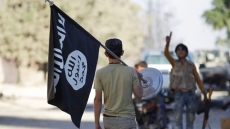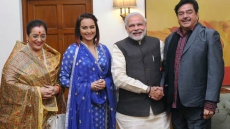As door 1 with Pakistan proxies supported by local hawks Hurriyat closes, door 2 with Islamic Caliphate written on it opens in what is a brutal cage match which has more or less eviscerated the lives of the Kashmiris in the Valley.
Door 2 is only slightly ajar, but it is being kicked open by the powerful imagery of the Pulwama bombing by a local youth Adil Ahmad Dar.
Dar has emerged as the latest poster child in the long line of local militants and ideologues beginning with Afzal Guru, Burhan Wani and then Zakir Musa. All young militants born out of the 'azadi' generation, birthed by the social media redefinition of freedom.

Political Islam morphing itself into a puritanical strain of religious Islam. The Indian deep state is concerned about the rise of indigenous militancy following the beliefs of IS, something that was stamped out by J&K super cop and former IGP S.M. Sahai, Kashmir Range, in the past.
As communities world wide close themselves and become more insular, shutting the door to the interloper who is seen as an Islamist jihadi, the clash of civilisations is now a grim reality. It could be Islam versus Christianity or Islam versus Hinduism or even pure Islam versus impure Islam playing out in different parts of the world.

What this shut down and battening down of hatches does is that people within those walls become impervious to intel. Access gets more difficult as walls emerge from within the closed user group. The world then is divided between the believers and the non believers. Kashmir, epicentre of Pakistan's bleed India to death stratagem, remains a hot button as far as Indian intelligence and security main frame is concerned.
Fear stalks one and all after the Sri Lanka bombings. The Islamist fundamentalist has TAKFIR ingrained in his psyche which asks him to target the apostate. So, there are three degrees of separation in TAKFIR, for it targets allegedly 'impure' Muslims too. Ergo, the targets could be Ahmediyas, Shias and Sufis which is how the sequencing around the world has been.

The Hefazat e Islam in Bangladesh for instance targeted Ahmediyas to draw attention to itself. The Shapla Square protests or Motijheel massacre in May, 2013
also called Operation Shapla or Operation Flash Out were part of this process. Hefazat e Islam, an Islamist pressure group, organised a mass demonstration in Dhaka's financial district demanding the enactment of the blasphemy law to stop Islamophobic content in media. As a deterrent, the government used Rapid Action Battalion and Border Guard to quell the protesters. This resulted in protests across the country in which estimates are of any number between 20 and 61 people died.
In Kashmir Valley, Hizbul Mujahideen militant commander Burhan Wani in his first video in August 2015 vowed to establish the Caliphate, urging the youth to take up arms in south Kashmir.

The six-minute video was a seminal moment for it was circulated via mobile messenger and other social media networks. The video showed Wani in an orchard with an assault rifle and a copy of the Holy Koran with two militants standing guard by his side. The emergence of this terror neophyte stunned the security apparatus for it went beyond the pale of merely espousing anti India rhetoric to a broader pan Islamist agenda of establishing the Caliphate in the Valley.
This was followed by his deputy Zakir Musa openly distancing himself from the Hurriyat and challenging them. The underpinning of Ansar Ghazwa e Hind was visible for the first time. In May 2017, Musa called for chopping off the heads of those standing in the way of Sharia roll out in Kashmir. He also parted ways with Hizbul and spoke of action against those propounding a secular state, read Hurriyat.
Husain Haqqani has explained this phenomenon succinctly in 'Prophecy and Jihad in the Indian Subcontinent' -- Radical Islamists invoke the Hadith (the oral traditions attributed to the Prophet Muhammad) to prophesize a great battle in India between true believers and unbelievers before the end-times.
These references in the Hadith to the Ghazwa-e-Hind (Battle of India) infuse South Asia with importance as a battleground in the efforts to create an Islamic Caliphate resembling the social order that existed at the time of the Prophet Muhammad and the Rightly Guided Caliphs (632-661 AD)...Just as the prophecies of Khurasan became popular during the wars in Afghanistan, the Ghazwa-e-Hind divinations became a staple of the Islamist discourse after the launch of jihad in Indian-controlled parts of Kashmir in 1989.
Throughout the 1990s, Pakistani official media also encouraged discussion of the Ghazwa-e-Hind Hadith to motivate jihadists. In fact, every major Pakistan-based jihadi group that launched terrorist attacks across the border claimed that their operations were part of the Battle for India promised by the Prophet. For these Pakistani groups, supported by Pakistan's Inter-Services Intelligence agency, the target of jihad should be the modern state of India and its "occupation" of Kashmir.
For example, Lashkar-e-Taiba has often spoken of Ghazwa-e-Hind as a means of liberating Kashmir from Indian control. The group's founder, Hafiz Muhammad Saeed, has declared repeatedly that "[i]f freedom is not given to the Kashmiris, then we will occupy the whole of India including Kashmir. We will launch Ghazwa-e-Hind. Our homework is complete to get Kashmir." Pakistani propagandist Zaid Hamid has also repeatedly invoked Ghazwa-e-Hind as a battle against Hindu India led from Muslim Pakistan. According to Hamid, "Allah has destined the people of Pakistan" with victory and "Allah is the aid and helper of Pakistan."
Several Islamic scholars, especially from India, have questioned the veracity of the Ghazwa-e-Hind Hadith and reject its repeated contemporary citation as "Pakistani terrorists' anti-India propaganda."
According to Maulana Waris Mazhari of the Darul Uloom Deoband seminary in Uttar Pradesh, India, the conflict between India and Pakistan over Kashmir was not jihad; the dream of establishing "Muslim hegemony throughout the entire world" was fanciful. "The term ghalba-e Islam, the establishment of the supremacy of Islam, used in the context of the Quran and the sayings of the Prophet (Hadith),
refers not to any political project of Muslim domination," Mazhari wrote, "but, rather, to the establishment of the superiority of Islam's ideological and spiritual message."
The evolution from Kashmiri nationalism to Islamic Caliphate has been a calibrated move. Exterminating the non believer or the impure Muslim was the strategy. The defining moment is the assassination of Maulana Shaukat Ahmed in 2011. Maulana Shaukat Ahmed, the soft spoken 55-year-old chief of the Jamiat-e-Ahli-Hadees (JAH), became yet another victim of terrorist violence in strife-torn Kashmir Valley.
The Maulana had been heading the JAH since 2004, when he was first elected President of the organisation, followed by three more tenures in this responsible position. His last election came in 2010. The Jamiat-e-Ahli-Hadees grew under his leadership and had about 15 lakh followers and more than 800 mosques spread across the valley.
The cleric was a man of conviction who did not hesitate in speaking his mind. His organisation advocated a puritanical concept of Islam which is at variance with the more moderate Sufi Islam that is predominant in the valley. The ritualistic practioner of Islam began to think in terms of a loose mirror image of the Muslim Brotherhood in Kashmir.
The most recent unsettling news came earlier this month -- On May 10 the Amaq news agency of ISIS claimed that the group has established the 'Wilayah of Hind'. Amaq, however, did not elaborate the geographical limits of the so-called province. Interestingly, the proclamation coincided with the elimination of Ishfaq Ahmad Sofi, a
suspected operative of ISIS in India, by the security forces in an encounter in Shopian in south Kashmir on the same day. Uddipan Mukherjee, PhD, Joint Director, Government of India, Ministry of Defence at Ordnance Factory Board writing for IDSA explained the new phenomenon -- It is interesting to note that, in the context of the ISIS's recent proclamation on Kashmir, analysts were also of the opinion that global jihadist groups have failed to exploit the Kashmir conflict, unlike conflicts in Syria, Afghanistan and Iraq.
The fundamental reason, as put forward by Mohammed Sinan Siyech, in a paper in Counter Terrorist Trends and Analyses published in May 2018 was that the Kashmir issue is primarily a territorial and political dispute as opposed to a purely religious/Islamist conflict. Furthermore, cross-border terrorist groups like the Lashkar-e-Taiba and Jaish-e-Mohammad are in opposition to the concept of a pan-global
Islamic Caliphate. Consequently, ISIS has failed to establish its footprints in the Kashmir Valley. However, recent events are worrisome for the Indian defence establishment.

